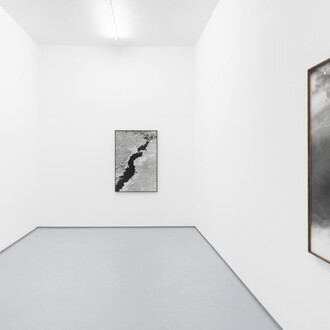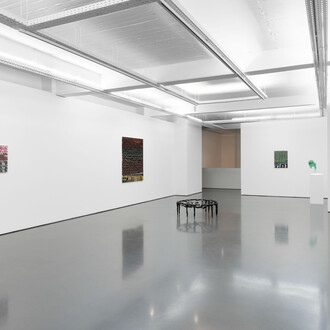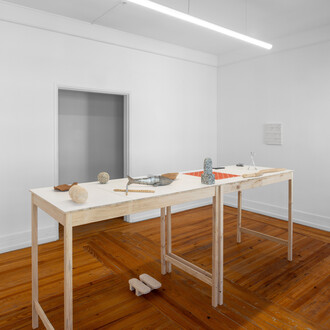Neither Valley nor Mountain.
The painting of Rui Miguel Leitão Ferreira consists of a delicate balance between what is stated and what happens. With foundations that are simultaneously both profoundly physical as well as spiritual, his work is a development of the intersection of different forms, rhythms, and ways of doing. Medium, material and action come together in a dialogue which is both thoughtful and intuitive, focussing on the relationship between the act of making marks on the canvas, the outcome of those marks, and what we make of what appears. With its criss-cross of overlapping layers, the dialogue shows us the desire of the artist to make a mark - applying the paint directly to the canvas, accepting the unknown result - when he covers, stamps, strips and lays bare the various layers of which the painting consists.
Highly physical in both structure and image, the works of Rui Ferreira emanate a density which breathe life. A density that comes from careful manipulation of his choice of materials, with recognition of their thickness, elasticity, opacity, and chemical reaction, as well as in his observation of the image and detailed understanding of what it is. To speak of the density of the painting and its inherent complexity leads us to notice the disarming simplicity of the production process, which embraces the accidental, the unforeseen and the uncontrollable. His work can be seen as a set of forces in balance, of desire and acceptance, of material and image, the complex and the simple.
Set in a world in which opposites collide, the works of Rui Ferreira demand a level of attentiveness of the viewer on many different levels. Although the canvases are large in both size and complexity, drawing us in to their field of influence, they also have qualities of closeness and privacy that invite us to look at them in greater detail. Oscillating between the vibrancy of the global and the delicacy of the private, the artist invites us to a slow, contemplative discovery of his work, allied to a strong sense of curiosity.
As we discover the work, we become aware of many presences that hide and reveal themselves, presences which question the very nature of painting itself. The artist superimposes a variety of figures which, during the evolution of the work, he hastens to thin down, or to rub out what remains by saturation of the surface of the canvas. Most of these presences are absorbed by the successive layers of paint, but a small number remain, ghost-like, at the back of the canvas. In each case we are talking about entities that are present during the development of the work, but which are not involved in the construction of the narrative and representational discourse.
One could say that the works follow a procedural logic, removing themselves from the need to illustrate, putting into practice a deconstruction of hierarchies and chronological references that allow the work to remain open for action. These values do not obey an order of procedure or a predefined strategy, and the actions are not sequential or linear, existing rather as a function that changes in agreement with the parts or the whole.
As this process or pathway moves onwards, the figures steal silently away, the marks of their presence becoming superimposed on the canvas, their meaning gaining expression. Our hands yearn to touch, and our eyes are drawn to an archaeological scrutiny in which we discover presences from the past, others that are in transformation, and others still that remain in existence. Consideration of the proximity of the material and the distance that the scale of the canvas imposes leads us to make a connection between the tactile and the visual, wandering between the intimacy of each fragment and the force of the work as a whole. In effect, with what can be seen, what is hidden, and the various layers and their intersected time periods, the painting of Rui Miguel Leitão Ferreira suggests that within a transitional field, everything moves in balance, without rules or stereotypes. The nature of the work does not offer references for us to hold on to, inviting us instead to consider the possibilities thrown up by a state of impermanence. This is what the painting demands, and it is what the artist provides. The same thing is invoked in the East, when to help position the hands during meditation we are asked to open ourselves to the possibility of being Neither Mountain nor Valley.
Sérgio Fazenda Rodrigues
















